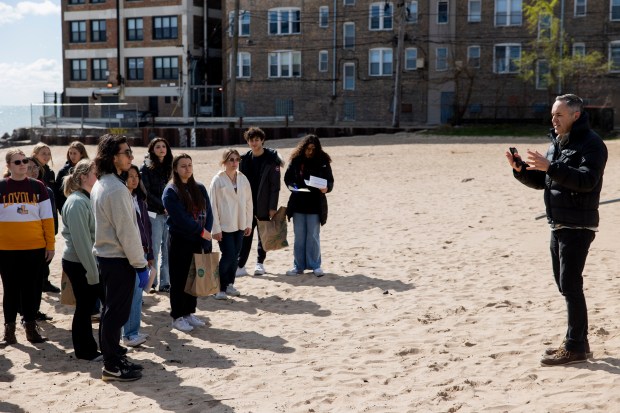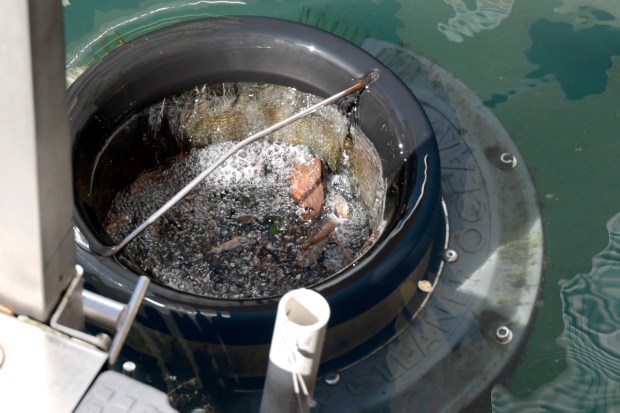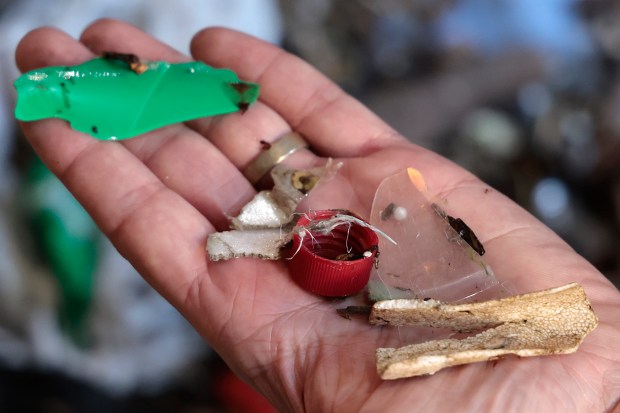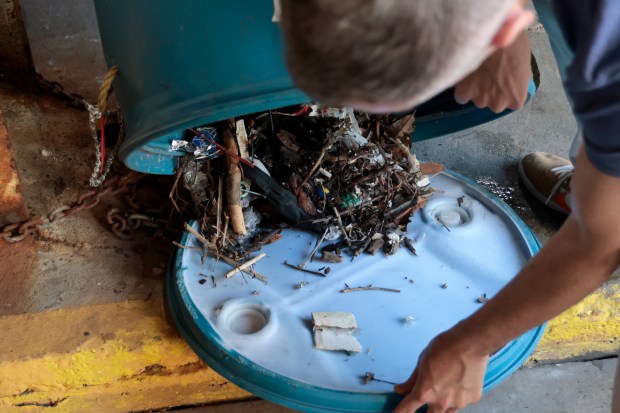Wendella engineer Miguel Chavez climbed down a ladder and over a small dock Wednesday to pull up a trap floating in the Chicago River near the Michigan Avenue Bridge. The size of a standard garbage can, the trap is designed to collect trash and can hold up to 44 pounds.
Chavez tapped the bin three times to release the contents into a trash bag. At first glance, it looked like a brownish, wet pile of leaves and twigs.
“Once you start sifting through it, it’s a lot easier to see the trash,” he said.
While large trash is not as big of a threat, plastic debris from food and product packaging and the smaller bits from when it breaks down has emerged as a persistent problem that affects wildlife, water quality and public health.
“It’s no longer the dumping ground it was — it’s more of this incidental, wind-blown picnic, restaurant, parking lot pollution,” said Margaret Frisbie, executive director of the nonprofit Friends of the Chicago River. “What we used to find was shopping carts and sofas and tires and old pipes. … It was big and messy, but not the way that we see litter today. Today, the litter is smaller, it’s food-related. It’s breaking down because it’s plastic, and so it’s never really going away.”
In 2023, the Metropolitan Water Reclamation District collected 675 tons of debris from the river using skimmer boats; on average they pick up 745 tons annually, according to a spokesperson. City of Chicago skimmer boats also remove trash regularly along the Riverwalk downtown.
Between 75% and 95% of debris collected in the river is plastic, and 58% of identifiable, non-fragmented trash is food-related, according to research led by Tim Hoellein, an aquatic ecologist at Loyola University Chicago, and undergraduate student Caitlin Hyatt.
Shortly after the trap’s deployment last summer, Mike McElroy, director of marine operations at Wendella Tours and Cruises, discovered a plastic toy dinosaur when he emptied the trap one day. Now the trap’s official mascot, Trappy the Dinosaur has become an emblem for all the different kinds of things that pollute the river.
The Trash Trap is the first technology of its kind used in the Chicago River to remove litter and learn where it’s coming from and what it’s made of. Contraptions like this are typically used in marinas where tides rise slowly, but this one was modified to withstand rapid changes in river levels from heavy rainfall.
It works by drawing in water and debris from the surface using a submersible pump, trapping litter inside a catch bin and pumping the water back out.
“From day one, it was pulling trash out of the river, even things that we couldn’t see readily with (our) eyes,” McElroy said. “The things we’ve pulled out have been very interesting. We’ve had a shoe, Dorito bags, Styrofoam in numbers and quantities that are just astounding.”
A common thread
Flowing from the Great Lakes and into the Mississippi River, the Chicago River connects the region to the rest of the country and the world. And plastic litter is a common thread that runs through these diverse water systems.
“That’s happening in our rivers too, it’s just not happening in the oceans,” Frisbie said. “It’s just not happening far away, it’s happening here too.”
Unsurprisingly, the composition of litter in the Chicago River mirrors that of the region’s lakes. In a recent report using data from over 14,000 beach cleanups over 20 years, the regional nonprofit Alliance for the Great Lakes found that 86% of trash entering the Great Lakes in a given year is either partially or fully composed of plastic.
“The other day I saw someone throw a bag of their leftover lunch over the wall from Wacker Drive,” Frisbie said.
Large plastic products such as single-use bags, straws, wrappers, takeout containers and utensils eventually break down into smaller plastic particles. The tiniest of these particles — less than 5 millimeters long or the size of a pencil eraser — are called microplastics and have been found in Great Lakes bony fish and drinking water, as well as human blood, organs and breast milk.
“A lot of what we find is fragments,” Hoellein said of river litter collected by the Trash Trap, which students at Loyola help sort and characterize.

Most of these fragments are generally smaller than an inch. Lentil-sized pellets used in plastic production called “nurdles” account for 5% to 20% of their weekly findings. Bits of Styrofoam broken down from food containers also present a ubiquitous problem.
“Sometimes there’s too many to count and we have to estimate,” Hoellein said.
“We also find a lot of these things,” Hoellein said, holding up a green dental floss pick. “I hate tooth flossers.” He soon found another green one, its color markedly faded.
In his research, he said, almost every fish he has looked at in the Chicago-Calumet River system has some form of microplastics inside them.
Despite these findings, advocates say that in an “amazing renaissance,” the Chicago-Calumet River system is healthier now than in the past 150 years. The river is home to all kinds of animals, including migratory birds, beavers and turtles, as well as 80 species of fish — up from less than 10 in the 1970s.
“That’s telling us that Mother Nature is healing herself,” said McElroy, who will lead a Saturday cleanup at Lucas Berg Nature Preserve in Palos Hills. “I think, through the efforts of the Friends of the Chicago River and others, that’s how we got to this point, as well as (through) the Clean Water Act. What would we do without that?”
When he started working with another boat tour company in 1988, McElroy said he couldn’t even see the bottom of the river on a sunny day. Now, he can.
“It’s incredible,” he said. “The water has become so much clearer.”
Restoring the health of the river has required a multipronged approach, Frisbie said, starting with the enforcement of a 2029 deadline to complete the Tunnel and Reservoir Plan — a system of deep tunnels and wide reservoirs for flood control — that will reduce combined sewer overflows, which occur when city pipes for stormwater runoff and sewage are overwhelmed with rains, pouring untreated human waste into the river.
The second step entails improving the disinfecting process of sewage effluent, or treated water, using chlorination or ultraviolet light to remove pathogens and bacteria. The nonprofit has also focused on championing nature-based solutions such as planting trees and creating parks that absorb stormwater and reduce runoff into waterways.
In April, the Illinois Environmental Protection Agency issued a new National Pollutant Discharge Elimination System permit to the city which will govern 184 city-owned outfalls that discharge into the Chicago-Calumet River system and the Des Plaines River. The new permit is more stringent and requires additional strategies to reduce pollution from sewage and litter.
“The last piece is this litter piece,” Frisbie said, which is where river cleanups come in.


Frisbie said the new permit issued to the city also includes the expansion of litter-control technologies such as skimmer boats and trash traps to remove plastic pollution along the 156-mile stretch of the river.
Researchers, organizations and companies are also looking to deploy more trash traps along the river. McElroy said Wendella plans to install one at the Chinatown water taxi stop in Ping Tom Memorial Park, and Hoellein is hoping to expand the scope of the research by partnering with other companies with riverfront locations.
Chicago River Day
Since 1992, volunteers with Friends of the Chicago River have picked up nearly 2 million pounds of trash from the river and its banks to help restore its aquatic ecosystems.
At the organization’s 32nd signature annual event Saturday, over 2,000 citizens, politicians and corporate teams will fan out across 87 locations in the city and suburbs, up from 80 sites last year and 77 the year before.
“People are starting to really understand the problem,” Frisbie said. “They are demanding that the places they live (in) are healthy and cared for.”
Registration for Saturday cleanups is required online at chicagoriver.org and will remain open for each site until it is full. Walk-up volunteers might be able to participate, though the organization cautions that space is limited.
Volunteers will also remove invasive plants such as garlic mustard, buckthorn and honeysuckle from Chicago Park District and the Forest Preserves locations as needed.
But river restoration efforts should not be a one-and-done thing, advocates say. Saturday will kick off a new season of the nonprofit’s Litter Free Chicago-Calumet River initiative.
Individuals and organizations can host community cleanups through the nonprofit’s Litter Free Supply Stations network, of which there are 13 across the watershed. Each station has tools such as litter grabbers, buckets, bags and gloves, as well as toolkit guidance in English and Spanish.
Environmental organizations use data gathered by volunteer citizens and research scientists to inform their advocacy, which then could become the foundation for policies that curb overproduction and overreliance on plastic products.
“The increase in individual use of disposable items in the last 20 to 30 years has skyrocketed. Everyone’s got a to-go cup of coffee every day, and sometimes three. … I think our relationship with plastic is forced upon us,” Frisbie said. “We can fight back. We turned the river around again, metaphorically. We can turn single-use plastic around as well, I believe.”



